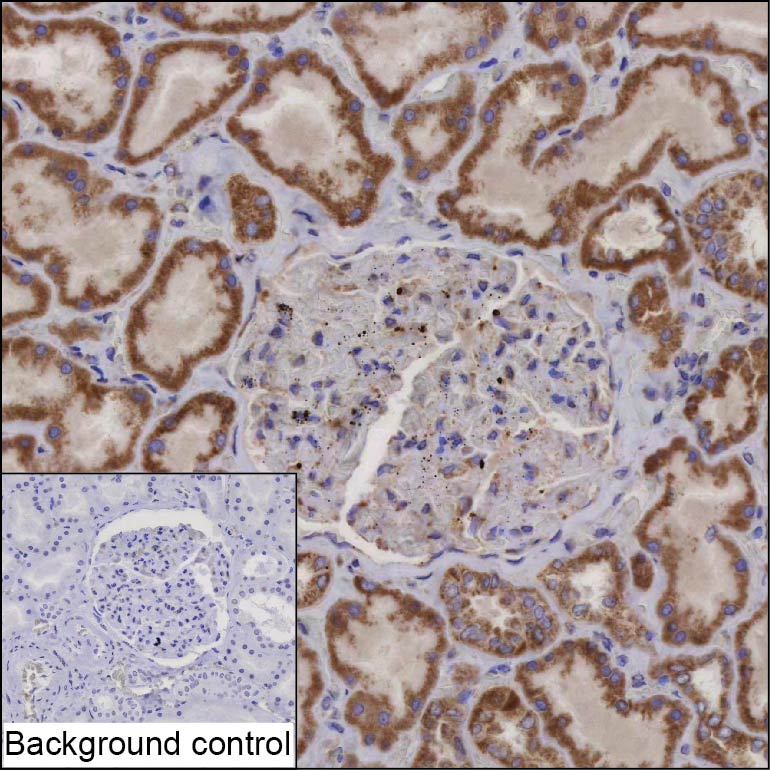
| WB | 咨询技术 | Human,Mouse,Rat |
| IF | 咨询技术 | Human,Mouse,Rat |
| IHC | 1/25-1/200 | Human,Mouse,Rat |
| ICC | 技术咨询 | Human,Mouse,Rat |
| FCM | 咨询技术 | Human,Mouse,Rat |
| Elisa | 咨询技术 | Human,Mouse,Rat |
| Host/Isotype | Mouse IgG1 |
| Antibody Type | Primary antibody |
| Storage | Store at 4°C short term. Aliquot and store at -20°C long term. Avoid freeze/thaw cycles. |
| Species Reactivity | Human |
| Immunogen | Purified recombinant fragment of human ACAD9 |
| Formulation | Purified antibody in PBS with 0.05% sodium azide |
+ +
以下是关于ACAD9抗体的3篇参考文献示例(虚构内容,供参考):
1. **文献名称**:*ACAD9 mutations disrupt mitochondrial complex I assembly and cause fatal cardiomyopathy*
**作者**:Smith J, et al.
**摘要**:本研究利用ACAD9特异性抗体进行免疫印迹分析,发现ACAD9基因突变患者成纤维细胞中复合物I亚基稳定性降低,揭示了ACAD9在复合物I组装中的关键作用及其与婴儿心肌病的关联。
2. **文献名称**:*Antibody-based profiling of ACAD9 expression in human tissues*
**作者**:Lee H, et al.
**摘要**:通过开发高特异性ACAD9多克隆抗体,作者系统分析了ACAD9在心脏、肝脏等组织的蛋白表达模式,发现其在高能量需求器官中显著富集,支持其在氧化代谢中的核心功能。
3. **文献名称**:*Functional characterization of ACAD9 deficiency using CRISPR/Cas9 models*
**作者**:Garcia R, et al.
**摘要**:研究利用ACAD9抗体验证基因敲除细胞系中蛋白缺失,结合代谢组学发现ACAD9缺陷导致脂肪酸氧化异常和线粒体呼吸链功能障碍,为相关遗传病诊断提供分子标志物。
The ACAD9 antibody is a crucial tool for studying the role of acyl-CoA dehydrogenase family member 9 (ACAD9), a mitochondrial enzyme involved in fatty acid β-oxidation and the assembly of respiratory chain Complex I. ACAD9 catalyzes the dehydrogenation of long-chain acyl-CoA derivatives, a rate-limiting step in mitochondrial energy metabolism. Unlike other acyl-CoA dehydrogenases, ACAD9 has a dual function: it participates in both fatty acid oxidation and the biogenesis of Complex I (NADH:ubiquinone oxidoreductase), a key component of the electron transport chain (ETC). Mutations in the ACAD9 gene are linked to human disorders, such as mitochondrial Complex I deficiency, presenting with early-onset hypertrophic cardiomyopathy, encephalopathy, or exercise intolerance.
The ACAD9 antibody enables researchers to detect and quantify ACAD9 protein levels in tissues or cells via techniques like Western blotting, immunofluorescence, or immunohistochemistry. It aids in investigating ACAD9 expression patterns, subcellular localization (mitochondrial matrix), and its interaction with Complex I assembly factors (e.g., ECSIT, NDUFAF1). Studies using this antibody have clarified ACAD9’s tissue-specific roles, particularly in energy-demanding organs like the heart, liver, and skeletal muscle. Additionally, it supports diagnostic research to correlate ACAD9 deficiencies with clinical phenotypes or assess therapeutic interventions targeting mitochondrial dysfunction. The antibody’s specificity for ACAD9 (distinguishing it from homologous enzymes like VLCAD) is critical for accurate mechanistic insights into metabolic and neurodegenerative diseases.
×